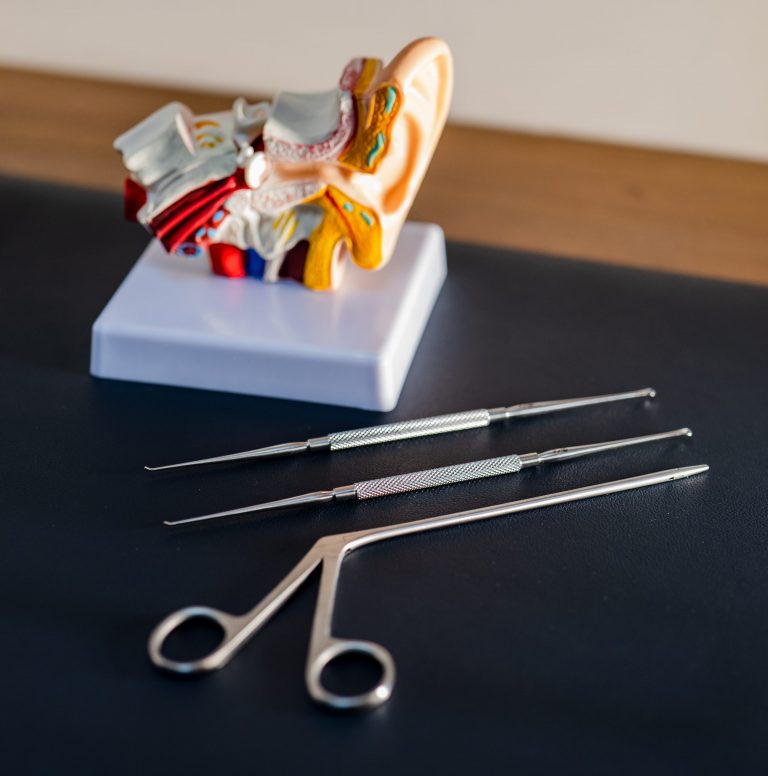Introduction
Ear wax, or cerumen, is made by our bodies to protect our ears from dust, debris, and bacteria. Ear wax is important for protecting our ears, but too much can cause problems. It can lead to discomfort and affect our hearing ability.
There are different methods available to remove excess ear wax. These methods can help restore clarity to your hearing. This article explores various ear wax removal methods. Choose the best option for your needs.
One of the most common ways people address excess ear wax is through home remedies. These remedies use household items to naturally soften or remove wax.
One such method involves using warm water and a bulb syringe to flush out the excess wax. To do this at home, you’ll need a clean bowl. The bowl should be filled with warm water at body temperature. You’ll also need a bulb syringe designed for ear irrigation. Kensington Hearing does not recommend self-irrigation. However, for this article, we outline best practices.
Tilt your head sideways towards the bowl. Insert the syringe’s tip into your ear canal gently. Don’t apply too much pressure. Squeeze the bulb to flush out the softened wax. One popular home remedy is using olive oil or hydrogen peroxide drops. These drops help soften the earwax before the treatment.
To use this method, lie on your side. Keep one ear facing up. Apply a few drops of either substance to your ear canal. Use a dropper or a cotton ball soaked in olive oil or hydrogen peroxide solution. Allow the drops to sit in your ear for a few minutes. Then, tilt your head in the opposite direction to drain any excess liquid and softened wax.
Home remedies can help with minor excess earwax build-up. Over-the-counter solutions offer alternative options. Pharmacies sell ear-drops that dissolve stubborn earwax from our ears. These ear-drops are designed for this purpose.
Typically, these solutions have active ingredients like peroxide. This ingredient helps break down the wax and makes it easier to remove. To use these products, follow the instructions on the packaging. To apply, put a few drops in the affected ear. Then, wait for a specific amount of time.
Then, tilt your head to encourage drainage of any dislodged wax. You can find various professional interventions in Kensington, London. These interventions are available at clinics and specialised healthcare providers.
These professionals have extensive training. They also have experience in safely removing earwax. They use advanced techniques. Microsuction is a widely used method. It involves using a suction device. The device has a low-pressure vacuum system. The purpose is to extract excess wax from the ear canal.
This method is safe and efficient. It provides precise control over the extraction process. It also minimises discomfort for patients. There are various methods to remove excessive ear wax build-up. Here are a few examples of these methods.
You can either try natural home remedies or seek professional help. There’s an option that will fit your needs. Approach any method with caution. Consult a healthcare professional for severe ear pain. Seek medical advice if you suspect other underlying conditions.
Ear health is vital for overall well-being, so don’t hesitate to seek help when needed. Stay tuned for our next section. We will explore different over-the-counter solutions. These solutions can aid in removing excess earwax.

Home Remedies
Many individuals choose to try home remedies for ear wax first. Then they consider seeking professional assistance. Don’t worry if you find yourself in this situation. There are a few methods you can try at home. One popular home remedy for ear wax removal is the use of warm water.
To do this, fill a clean bowl or basin with warm water (not too hot!) and dip a clean cloth or towel into it. Gently wring out excess water and then place the damp cloth against your ear for a few minutes.
The warmth will help soften the ear wax, making it easier to remove. Another effective home remedy is the use of hydrogen peroxide.
Most medicine cabinets contain this common item that helps clear ear wax buildup. Start by tilting your head sideways. Use a dropper to put a few drops of hydrogen peroxide into your affected ear.
Allow it to sit for about 5 minutes while massaging the outside of your ear gently. Then, tilt your head back and let the solution drain out onto a towel or tissue.
Repeat this process if necessary. You can use baby oil or mineral oil as a home remedy for softening ear wax.
Warm up some oil slightly, making sure it’s not too hot. Use an eyedropper to put a few drops into your affected ear. Allow the item to rest for a few minutes. Then let it drain naturally or use gentle rinsing techniques. You can tilt your head sideways for this.
Remember, home remedies can help some but not all people. They may cause discomfort if used incorrectly. If you feel pain, dizziness, or symptoms get worse, stop. Consult a healthcare professional right away.
When facing an excess buildup of ear wax, there are various home remedies available for you to try. You can use warm, or mineral oil. These options help soften the wax and make it easier to remove.
Approach these methods cautiously. Discontinue if adverse effects occur. If the problem continues or worsens, it’s best to consult a professional for ear wax issues.

Over-the-Counter Solutions
There are many over-the-counter solutions for dealing with too much ear wax. These solutions can come to the rescue. These products are easily accessible and allow you to remove excess ear wax at home. You don’t need professional help. Let’s explore some of these OTC solutions and learn how they can help keep your ears clean and clear.
One popular over-the-counter option is ear drops. These drops are made to soften stubborn ear wax. They help loosen it, making removal easier.
Usually, these products have hydrogen peroxide and oil. These ingredients break down hardened wax effectively. To use them, lie on your side with the affected ear facing up. Carefully tilt the bottle and squeeze a few drops into the ear canal.
Then, gently massage the area around your ear to allow the drops to reach deep inside. After a few minutes, tilt your head to let any excess liquid drain out.
Another common OTC solution is an ear wax removal syringe or bulb syringe kit. These kits usually have a syringe or bulb syringe. They also come with a special solution to dissolve and flush out stubborn ear wax.
To use them, mix warm water with the solution provided. Follow the instructions on the package. Place the tip of the syringe or bulb syringe at the entrance of your ear canal. Do not insert it too far inside. Squeeze while aiming towards the roof of your mouth.
The pressure created by this technique helps dislodge and wash away excess wax buildup. There are different foam-based products available for purchase over the counter. These options are also in addition to the above choices.
Foams expand in ear canal, trap wax particles, and solidify into mass. Later, remove. Follow the instructions on the package for inserting foam in your ears. Let it work for a few minutes, then rinse it out.
It is crucial to note that this method may not work for everyone. It can cause discomfort or irritation. Therefore, consulting a healthcare professional before using foam-based solutions is recommended. When dealing with ear wax, remember that over-the-counter solutions can help. However, if you have persistent symptoms or concerns, consult a medical professional.
Professional Intervention
Dealing with stubborn or impacted ear wax? Leave it to professionals. Professional intervention for ear wax removal is safe and effective. It is a good option if other methods fail. One popular method used by professionals is irrigation or syringing.
To remove earwax, flush the ear canal with warm water. Use saline solution if needed. Specialised equipment is used. It allows for controlled pressure and precise targeting. The affected area is the focus.
The procedure is usually painless. However, some people may feel slight discomfort or temporary dizziness. Another professional method is microsuction.
The technique uses a small handheld vacuum device. The device has a gentle suction tip to delicately extract earwax. Microsuction is great for people with sensitive ears or perforated eardrums. It doesn’t use water or liquid in the ear canal.
It is praised as a very effective and safe method. Many people who are prone to infections or complications prefer it. Professionals sometimes use special tools, like curettes or loops, to remove hardened earwax. These tools scoop out the wax from the ear canal.
To perform this method safely, seek experienced healthcare providers for assistance. They must have precision and expertise to avoid harming your delicate ears. Remember, if you choose irrigation, microsuction, or instrumentation methods, it’s important to seek professional help. This way, you can ensure that your ear wax problems are handled by experts.
To safely remove hardened earwax, professionals use special tools like curettes or loops. These tools scoop out the wax from the ear canal. It’s important to seek experienced healthcare providers for help. They have the precision and expertise to avoid harming your delicate ears. If you choose irrigation, microsuction, or instrumentation methods, professional help is crucial. Many clinics and medical centres offer these services. Trained specialists know how to deal with different blockages while minimising risks. If home remedies and over-the-counter solutions don’t work, seek professional help. Your ears will thank you.
Kensington Hearing provides ear wax removal by certified audiologists. The fee for this service is a flat £65.00. If you are dealing with excessive wax, you can schedule a same-day appointment

Conclusion
There are various methods to remove ear wax. These methods cater to different needs. You can choose to use easy home remedies. You can also use over-the-counter solutions. Additionally, you can seek professional help. There are options available to suit your preferences. Ear wax removal kits can effectively and safely remove stubborn build-up. Even if you like to do it yourself.
When taking care of your ears, remember to prioritise safety. It is important to follow proper guidelines for ear care. Do not use sharp objects in your ears. Examples include cotton swabs and hairpins. These objects can cause injury and push wax deeper into the ear canal.
Instead, rely on gentle methods that involve softening the wax and allowing it to come out. So don’t let ear wax become a source of discomfort or irritation.
Explore different methods to take charge of your ear health. Find what works best for you. Keeping your ears clean and free from excess wax is important. It helps you enjoy optimal hearing and overall well-being.
You can choose a method that suits you best. In Kensington, London, you can try simple home remedies. These remedies include warm water rinses or hydrogen peroxide drops. You can also purchase over-the-counter solutions like ear drops or irrigation kits from your local pharmacy. Lastly, you can seek professional help from an audiologist or ENT specialist in case of severe blockages. Remember to prioritise regular cleaning and seek help for healthy ears.
In the end, with all these options at hand, there’s no need to let stubborn ear wax dampen your spirits. Maintain good aural hygiene to improve communication and everyday experiences. Clear ears pave the way for clearer communication and enhanced experiences.
This article was based on the following references:
- Robinson AC, Hawke M. The efficacy of ceruminolytics: everything old is new again. J Otolaryngol. 1989;18(6):263–267. – PubMed
